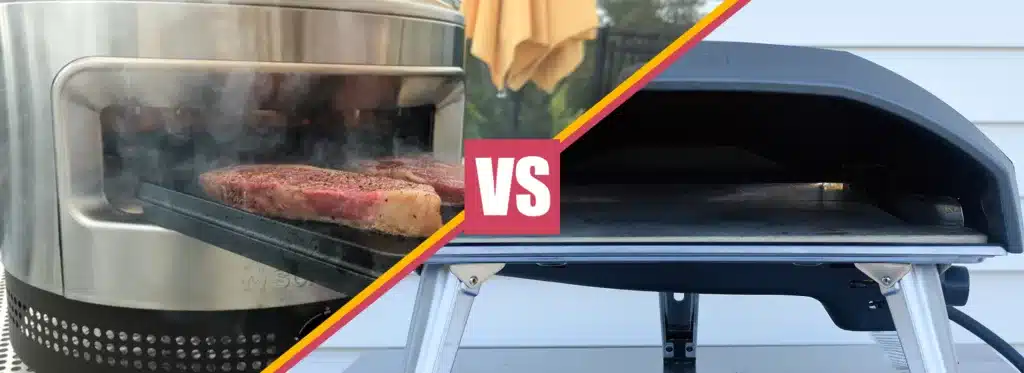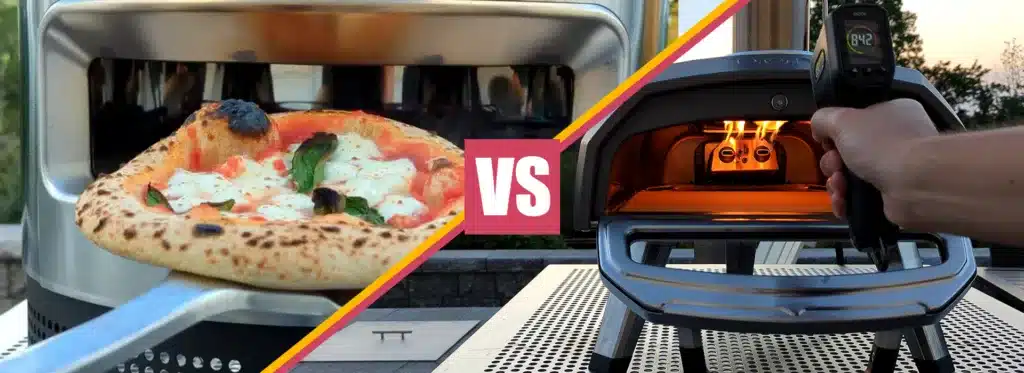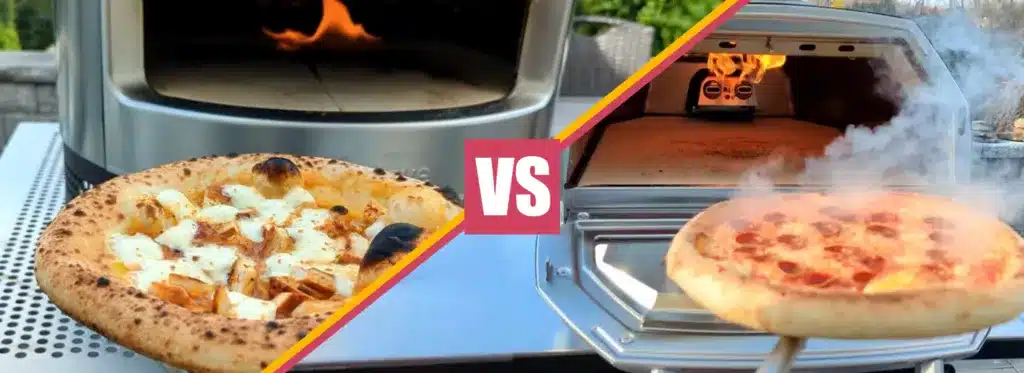Over the last two years, there’s been a huge surge in interest for portable outdoor pizza ovens. As an enthusiast myself, I’ve had the pleasure of using both of Solo Stove’s pizza ovens (Pi and Pi Prime), in addition to using all of Ooni’s offerings.
Ooni has historically been the leading brand in this niche market, but Solo Stove came out of left field with their first pizza oven and it was a major hit. Each brand offers a unique take on the perfect portable pizza oven, but they come with distinct features, design elements, and cooking capabilities.
My experiences with both the Solo Stove Pi and the various models of Ooni pizza ovens have provided me with a clear picture of what each one can offer. Solo Stove, known for its efficient and smokeless fire pits, applies similar principles to its Pi oven, focusing on precise airflow and simple designs. Ooni, on the other hand, is praised for its wide range of ovens that cater to different fuels and size preferences, most of which have no problem reaching temperatures above 950F.
Let’s take a closer look at each Solo Stove Pi pizza oven and compare them to Ooni.
Solo Stove Pizza Ovens
Solo Stove has two primary models of pizza ovens, both of which are designed for 12″ pizzas. The Solo Pi is their flagship multi-fuel oven which can switch from propane fuel to wood-fire in under a minute. The newer Solo Pi Prime is propane-only; this streamlined oven significantly cuts costs, making it one of the more affordable options.
Solo Pi
Fuel: Propane or Wood
Price: ~$490
My review: The Solo Pi multi-fuel oven completely surprised me in terms of performance. I didn’t expect this design to work so well, but it heats up to 900+F and can make great Neapolitans. The burner also goes low enough to make great low-and-slow New Yorks.
Converting to wood-burning is easy, but cooking with it is a bit more cumbersome compared to other multi-fuel ovens. Removing the rear hatch to re-fuel gets you a bit too close and personal with the flames, and it’s easy to go overboard (a little wood goes a long way). These are not big negatives in any way – just a bit of a bigger learning curve.
Overall, I absolutely love using this with the gas burner.
Solo Pi Prime
Fuel: Propane
Price: Under $300
My review: The Solo Pi Prime is my new favorite offering from Solo Stove. You know how much I loved the gas burner on the original Solo Pi. Well, the new Prime model has an integrated gas burner rather than an attachment on the back of the oven. And even better, it weighs less and is roughly $200 cheaper!
The cooking performance is exactly the same between the OG Pi and new Pi Prime. So if you’re one who prefers cooking with gas anyway, it probably makes sense to go with this cheaper option.
Overall, the Solo Pi Prime catapulted itself to the top of my pizza oven rankings. It’s now my most recommended budget-friendly pizza oven.
There’s also one other lesser-known pizza oven called Solo Pi Fire. And while it was incredibly fun to use, this is an attachment for their firepit and not a true dedicated pizza oven.
Ooni Pizza Ovens vs Solo Stove Pi Pizza Ovens
Now, let’s take a quick look at Ooni’s models. I’ll start with the most direct comparison – the Ooni Koda.
Ooni Koda (vs Solo)

Best comparison: Ooni Koda 12 vs Solo Pi Prime
The Ooni Koda is a solid pick for beginners who know they will only want to use gas. The Koda 12 is the most direct comparison to the Solo Pi Prime oven not only due to the gas-only option, but the burner design as well. They both have very similar baking performances, but I find that the Koda performs worse in windy conditions due to the very large mouth opening.
I also really like the Pi’s stability from the consolidated dome design over the Koda with foldable legs; the latter of which is intended for portability, but I find the Solo Pi Prime very easy to move anyway since it’s so light of weight.
If it were a battle between Ooni Koda vs Solo, I’m picking the Solo Pi and/or Pi Prime (depending if you want wood as a fuel option).
WINNER
Ooni Karu 12G (vs Solo)

Best Comparison: Karu 12G vs Solo Pi (Multi-Fuel)
The new Ooni Karu 12G has a refreshed vibe with a new glass door, more insulation, and improved burner efficiency. An integrated thermometer also shows ambient air temperature inside the oven. The baking performance in this oven is superb; the torch-style burner can cook great Neapolitans around 75 seconds.
It’s also multi-fuel, and I very much prefer cooking with wood in the Karu vs the Solo Pi. Accessing the wood hatch in the Karu is also much easier (and safer, in my opinion) compared to the Solo.
I’m picking the Karu 12G over the Solo Pi (Multi-Fuel); HOWEVER, I’m picking the Solo Pi Prime over the Karu 12G. Why? Because of price. The 12G performance to cost ratio is better than the original multi-fuel Solo Pi, but the new Pi Prime is so cheap considering its performance.
WINNER
Karu 12G wins over Solo Pi
Solo Pi PRIME wins over Karu 12G
Ooni Karu 16 (vs Solo)

No Direct Comparison. Solo does not offer a 16″ pizza oven at this time.
The Ooni Karu 16 is one of my top-ranked ovens, among any brand. This beast offers a huge cooking area and is ultimately the most versatile oven. Between the choice of wood, gas, or charcoal, the addition of a door, and tons of cooking room, you can cook a lot more than just pizza in this.
Even though we can’t directly compare 16″ and 12″ ovens, we can still rank them based on features, price, and performance. The Karu 16 costs quite a bit more than both the Pi and Pi Prime, but my rankings put the Karu on top. It’s worth the price.
WINNER
Comparing Pizza Oven Features
When comparing the Solo Stove Pi and Ooni pizza ovens, I focus on their design, features, cost, and performance.
Design and Portability
The Solo Stove Pi uses a dome-shape design which is unique among portable pizza ovens. With its stainless steel construction, it’s both durable and relatively lightweight. The dimensions make it compact enough for easy transport, although it is often considered slightly less portable than some Ooni models.
In contrast, Ooni pizza ovens are renowned for their portable designs. They come in a variety of sizes (and therefore weights), but many models maintain foldable legs and covers with carry handles which makes them incredibly easy to move around. Both brands feature a modern aesthetic, fitting well into outdoor spaces.
Fuel Sources and Performance
Solo Stove Pi offers the versatility of using wood, charcoal, or gas as fuel. I’ve found that the Pi reaches high temperatures efficiently, although temperature control requires a bit of practice. It’s easy to add too much wood in this oven.
The Solo Pi PRIME, on the other hand, is their gas-only model. But with the elimination of wood-fired cooking comes a huge price cut.
Ooni, meanwhile, offers multiple fuel options, ranging from multi-fuel to gas-only. Different models cater to different preferences, but generally, Ooni ovens are capable of reaching high temperatures rapidly, often under 15 minutes. When you match this quick heating with the built-in door on the Karu models, this leads to a more fuel-efficient operation.
Both brands have amazing performance cooking pizzas, both New York style and Neapolitan.
Price, Value for Money, and Recommendations
When it comes to price, both Solo Stove and Ooni offer options across a spectrum. Ooni models tend to cost a premium, while the value for money for both brands can be assessed in terms of longevity, quality of materials, and cooking results.
I viewed the Solo Stove Pi as being a middle-of-the-road priced product, until they released their new gas-only model. They saved a ton of cost on this pizza oven, making it single-handedly the best overall budget pizza oven.
Frequently Asked Questions
What are the key differences between the Solo Stove Pi and Ooni pizza ovens?
Solo Stove Pi is known for its sleek stainless steel construction, unique dome shape, wide mouth opening, and low cost. Ooni ovens, on the other hand, offer a wider variety of fuel options, a broader selection of sizes, and are considered a more premium product.
Are there any distinct advantages of using Solo Stove Pi’s accessories over those available for Ooni ovens?
Solo Stove Pi’s accessories are specifically designed to seamlessly integrate with their ovens’ design and functionality. They provide a tailored experience, which might not be as easily replicated with Ooni’s accessories that are designed for a broader range of models. I highly recommend using the accessories of the same brand oven you plan on using.
How do the prices of Solo Stove Pi and Ooni pizza ovens compare?
Generally, Ooni pizza ovens cover a wide price range, but are often considered high-end products. Solo Stove Pi typically positions itself in the budget-end of the spectrum.
Which pizza oven tends to reach higher temperatures, the Solo Stove Pi or the Ooni?
Ooni ovens are renowned for reaching extremely high temperatures quickly—often up to 950°F—allowing for rapid pizza cooking. Solo Stove Pi also achieves high temperatures but may not always reach the same peaks as Ooni, depending on the model.
What are the unique features of the Solo Stove Pi Prime compared to the dual fuel model?
The Solo Stove Pi Prime is a propane gas-only model, which saves a lot of cost when compared to the multi-fuel Pi. The original Solo Pi pizza oven costs more due to the additional design considerations to accommodate multiple fuels.

